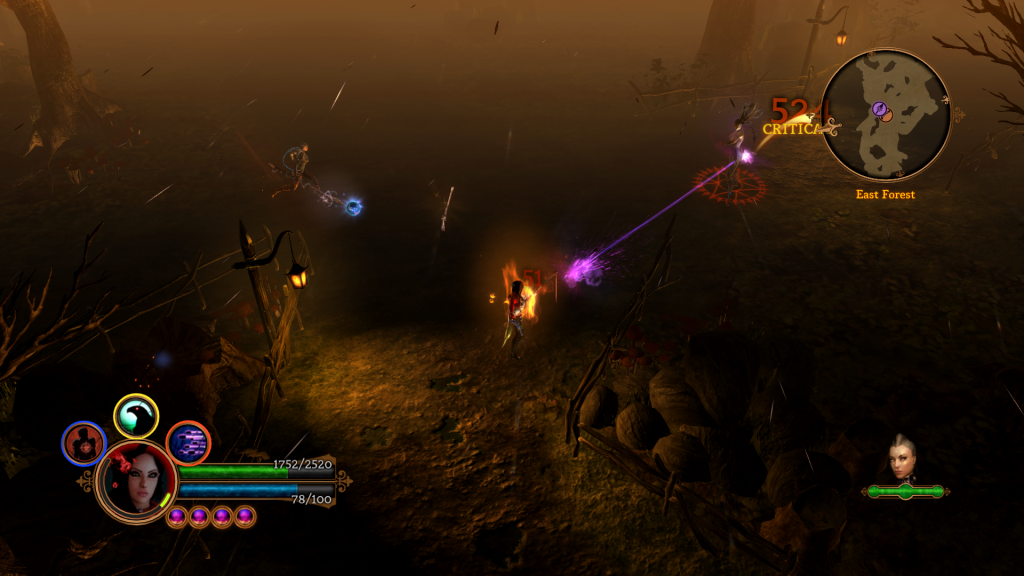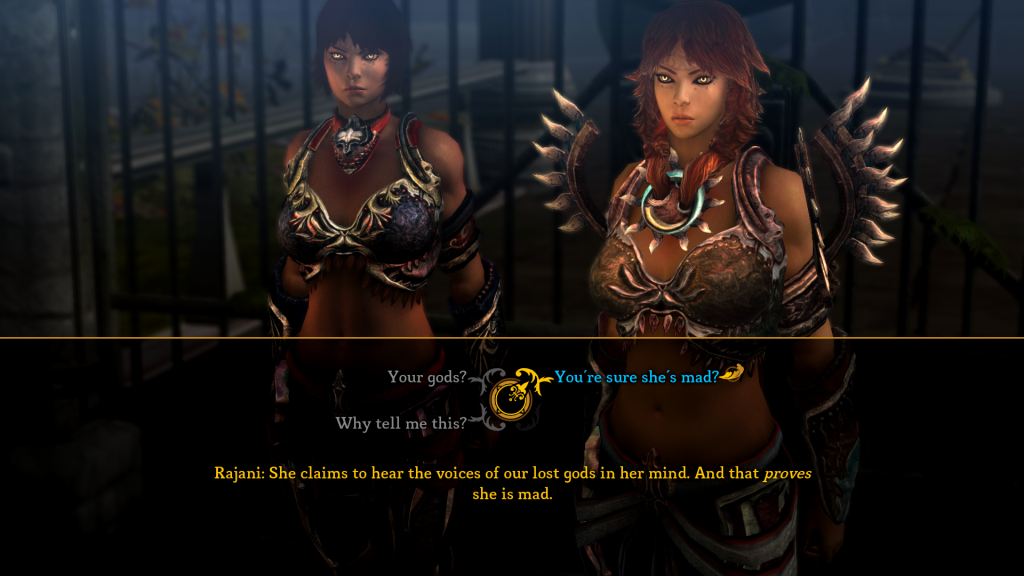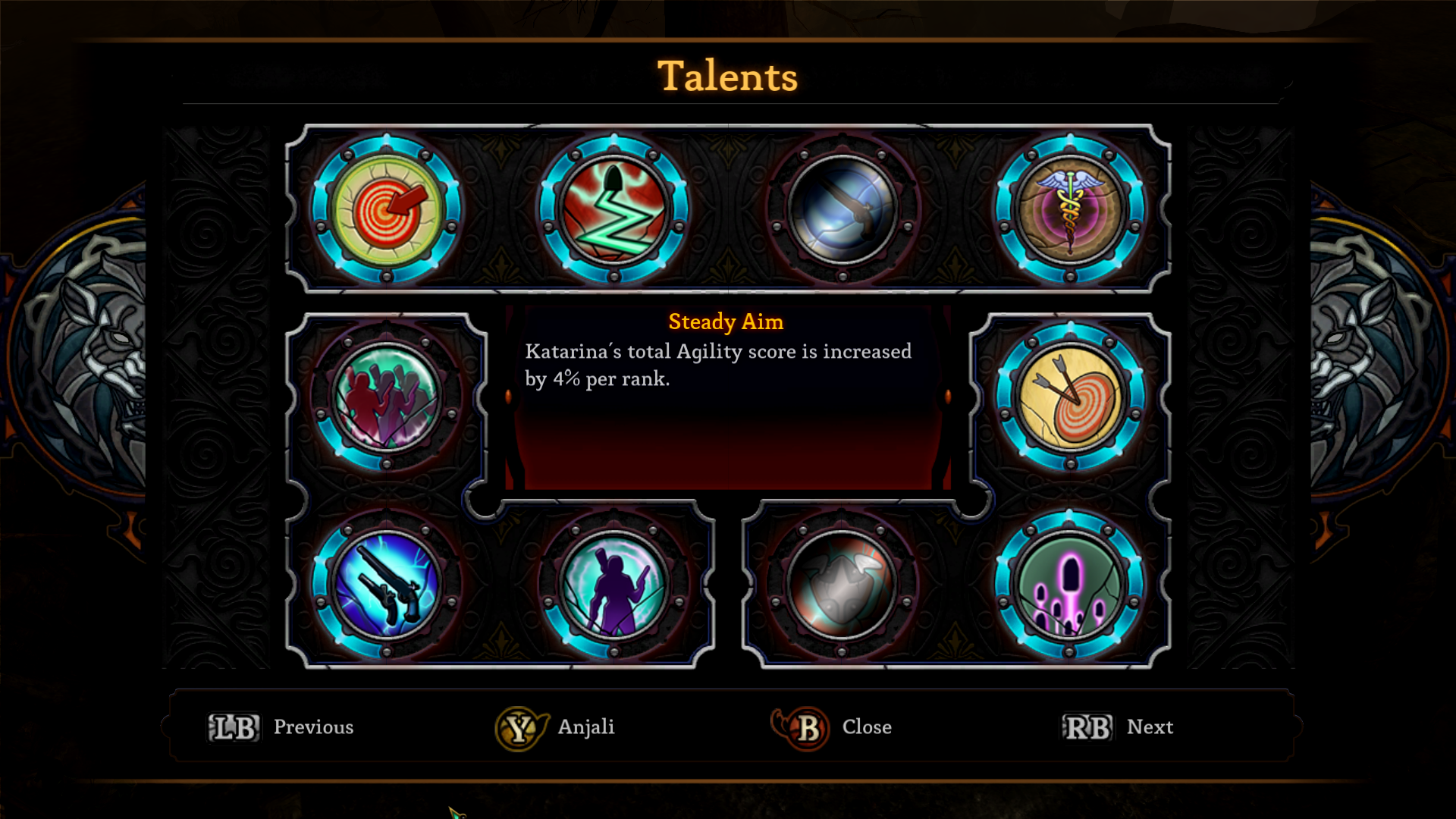
Game: Dungeon Siege III
Developer: Obsidian Entertainment
Genre: Action Role-Playing Game
Releases: 2011 (PC, PlayStation 3, Xbox 360)
Let us assume that you, dear reader, have read something about “Dungeon Siege” before if you found yourself reading this article. It might have been the articles about the original “Dungeon Siege” or the follow-up “Dungeon Siege 2” on this very blog, or maybe some other source entirely. What you would expect is that a game that has a “3” in the title kind of resembles the two predecessors since the name and franchise makes it easier to market games of the same genre with possibly even a similar story. Well, “Dungeon Siege III” is different than that in many ways, since it is not allowing you to take control of a party of adventurers anymore (one of the main features of the first two games), it is not a PC-centered “hack-and-slay”-esque roleplaying game, and whatever you have read about some “Second Cataclysm” as the cliff-hanger of “Dungeon Siege 2” is gone and never to be brought up again; unless you play the PSP-offshoot called “Dungeon Siege: Throne of Agony”. I write this like Gas Powered Games, the developers of the first two titles, had a choice in the matter, but from all I read online it sounds like they needed cash, joined up with Square Enix, and then got the terms to work with; whether they liked them or not. Chris Taylor, the face behind the first two “Dungeon Siege” titles, worked as an advisor for the development of the game, but the rest was up to Obsidian. Nonetheless, they produced a game that might have little to do with its past but was instead looking towards the future. So, let us talk about the good and bad of “Dungeon Siege III”.
The story of “Dungeon Siege III” plays 150 years after the events of the original “Dungeon Siege”, giving a nod to pre-existing worlds but making enough of a gap to never having to refer to the predecessors. Granted, Obsidian made stunning games with titles like “Fallout: New Vegas” being a prime example for how well they can make believable and interesting videogame worlds, but with the “Dungeon Siege” license there was probably not that much to work with. That would explain why they pretty much decided to go and make their own story instead of working with the “ancient evil does bad shit”-plots that “Dungeon Siege” and “Dungeon Siege 2” introduced. The story they came up with goes as follows: Some decades ago, the king during those times died due to an assassination attempt, but if I remember correctly not from the assassination itself, but rather from the turmoil that stemmed from it. The coup was planned and executed by one of the highest members of the 10th Legion, which then faced the wrath of a woman named Jeyne Kassynder; and believe me, you are going to hear this name an awful lot. Her goal in life seems to be the eradication of anything that swears loyalty to the Legion in any way, shape, or form, and due to her pursuits she managed to bring down this once mighty force to only a handful of people. Over the course of the story you will learn that she is actually that past king’s daughter and therefore claims the right to the throne, while also happening to be an Archon, a magical and powerful being of which one is even a playable character. In fact, if you are aware of the conflict between Jeyne Kassynder and the remains of the 10th Legion, you are perfectly set up because every meaningful action happens to have a correlation to that conflict, while anything else is just side quest filler that does not end up anywhere. One example for that is one of the first real quests that you gain after entering Raven’s Rill, a small village. You get contacted by some man about working for some witches which eventually want control over a nearby estate. You can give it to them at the end of that quest or deny them to stay there, but that does not go anywhere despite both characters saying that they work for incredible powers in the shadows and so on. I have no issue doing meaningless and menial side quests in roleplaying games, but there was so much build-up for that pair that I was convinced they would play some major role down the line.
But so far, everything shapes up to be following the normal fantasy videogame formula: Evil opposition in form of one cult of personality fights against the inevitably good, which overcomes the evil by sticking together, finding new allies and/or equipment, or simply being destined to do so. However, the story slightly alters depending on which character you choose to play. Other than in the two games before, you cannot make your own character in “Dungeon Siege III” and instead choose one of four pre-made characters: Lucas Montbarron, the melee guy that can switch between a two-handed melee weapon and a one-hand melee weapon with a shield combo, Anjali the Archon, who can decide to stay in a rather normal human form or can take a shot at her fire-elemental Archon form, Katarina, a gunslinger with the choice between two pistols and one rifle as her weapons of choice, or Reinhart Manx, a mage that can switch between a melee-centered and a ranged build. One interesting take is that you do not have to choose one of the layout once you have chosen your character since you can simply change the weapons/fighting style mid-fight, which allows for some interesting and creative use of abilities. Let us go into further detail how customizing your character works in “Dungeon Siege III”, for which I will talk about Katarina as the example since she was the character I have chosen to play through the game with. There are three tiers of abilities, which you will eventually unlock due to level progression. The first row from top to bottom in the ability screen are all the skills you can use in rifle mode, the second row contains the pistol skills, while the last row is made up of buffs and healing skills that you can activate in either mode when blocking. Each of those skills costs a certain amount of energy, but you can restore that by attacking the opponent with your normal attack. So, battles normally consist of you using normal attacks to get to use the flashy ones, while also switching modes to whatever suits the current situation. Katarina’s rifle has good damage and incredible range, but due to firing extremely slowly is hard to use once the opponent enters melee range. No problem, simply switch to the pistols, make a dodge roll, fire a volley, and repeat until the opponent is tired of you or of living, whatever comes first.

The skills, at least in Katarina’s case, seemed slightly weird at first, but there are some really solid combinations in there to work with. Since she is half witch due to her heritage, she can use curses to weaken the opponent, she can gain a really useful auto-fire mode that turns her rifle into a machine gun that fires for as long as you have the energy to pay it, or you can summon a ghost dog to help you in the fight by dealing additional damage and drawing aggro while you can fire away in peace. Depending on what abilities you like best, you can also invest into proficiencies, which improve the chosen ability in one of two ways that are given as options, allowing you to customize your version of the pre-made character just a little bit. There are also talents that you can level into, which give static bonuses like extra crit change or damage, more stats, situational healing, and many more things. Again, since each character is limited to ten different talents in total and you having to spend points into the early one since you need to unlock them via level, there is not as much creativity involved as you might think; but I still appreciate the effort. This is what keeps you in “Dungeon Siege III” in my opinion; at least, that is what kept me playing it. The fighting system is certainly not unique and parallels to the “Dragon Age” games are easy to find, but the fights were still fun and engaging, and oftentimes even forced some strategic thinking to not stand in a rain of goblin grenades or in the path of a cyclops furiously stomping towards me.
That does not necessarily mean you’re in for a fun time though. Character builds are hard to make if you do not understand what the attributes even do; and I sure as hell could not tell you what the “Doom” stat is for. What does it mean when a weapon has “Chaos: Bloodletting”? Why make damage over time effects have different durations for no good reason? Against what value does “Stagger” work? Is 39 a good stat in “Stagger”? What is “Momentum”? Or “Retribution”? Or “Warding”? There are so many stats and unimportant details in the game that ultimately do not seem to make a difference and are just busy-work to manage. You can find the answer for the questions above in the help menu in-game, but in all honesty I would not recommend wasting your time with that. As a matter of fact, I stopped looking at most of those stats after a while, and only focused on attack for obviously reasons, and stamina for more health. The writer of this eurogamer.net article made the choice of equipment even simpler for himself: “[Looting in Dungeon Siege III is] miserable. Fortunately, it’s easily fixed by opening your equipment menu once every 30 minutes and simply equipping the most expensive item you have in each category.” Simply adding more lines of text to a weapon does not automatically make it better, and having to read a short essay before I can even begin to understand how the chances for those chaos stats are and whether it is worth picking over another option is not something that I want to do in “Dungeon Siege III”.

One thing that also becomes apparant really quickly is that the game is made for consoles. Feel free to plug in your controller for this one, since you make your life a lot easier this way. However, regardless of your method of playing the game, you always have a valuable asset at your side. After a while, you will have all four of the aforementioned characters in your party (although only one will actively fight alongside you), but AI is definitely capable. Sure, my Anjali was blissfully unaware of any damaging floor when could stand upon and she definitely got whacked rather hard in some fights, but she was always capable of drawing attention away from the gunner lady, keeping enemies in check, and even dishing out some serious damage. Playing the game solo is therefore not as much of a handycap as you might think, even though the game seriously wants to push you towards four-player co-op since many of the achievements can only be gained that way. I cannot say how good the co-op experience in “Dungeon Siege III” is, but as a matter of fact only the host can keep the loot and XP that were found in your adventures together with others; the rest is simply resetted back to the status of the solo-player save, which is certainly a braindead system for a multiplayer game.
All in all, “Dungeon Siege III” is an action role-playing game that should keep you busy for around ten hours. It was also the “Dungeon Siege” game that I liked the most. Whether that is because I disliked the first two and the third installment having nothing to do with those previous games is certainly a possibility. However, the reverse is also true for many players since “Dungeon Siege III” is so different that hardcore fans of “Dungeon Siege” and “Dungeon Siege 2” refuse to acknowledge the third game as canon. I for one can only say that this is one of the game that I marked as an experience and then deinstalled to never be played again. If you are actually interested in giving the game a go, I would recommend buying the entire trilogy during the Steam Sale for about 5€, which in my opinion is a price that does not hurt that much if you find out that you do not like it.



